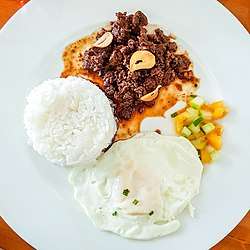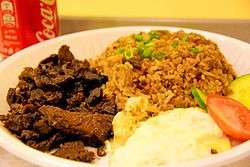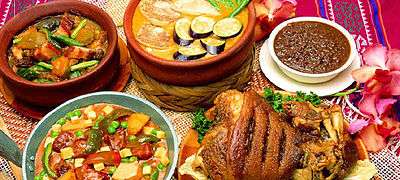Tapa (Filipino cuisine)
Tapa is dried or cured beef, mutton, venison or horse meat, although other meat or even fish may be used. Filipinos prepare tapa by using thin slices of meat and curing these with salt and spices as a preservation method.
 Beef tapa with steamed rice, fried sunny-side up eggs and sliced tomatoes and cucumbers | |
| Type | Meat |
|---|---|
| Course | Main course |
| Place of origin | Philippines |
| Main ingredients | Beef, pork, chicken, or fish; salt and spices |
| Variations | dried or cured |
Tapa is often cooked fried or grilled. When served with fried rice and fried egg, it is known as tapsilog (a portmanteau of the Filipino words tapa, sinangag and itlog egg). It sometimes comes with atchara, pickled papaya strips, or sliced tomatoes as side dish. Vinegar or ketchup is usually used as a condiment.
Etymology
Tapa in Philippine languages originally meant fish or meat preserved by smoking. In the Spanish Philippines, it came to refer to meats also preserved by other means. It's derived from Proto-Malayo-Polynesian *tapa, which in turn is derived from Proto-Austronesian *Capa. Tinapa (literally "prepared by smoking") is another cognate, though it usually refers to smoked fish.[1]
Dishes
Before cooking tapa, the meat is cured or dried and cut in to small portions or thin slices. As a method of preservation, salt and spices are added. After preparation, the meat can be cooked either grilled or fried.
Just like any other ulam (main dish) in Filipino cuisine, tapa is usually partnered with rice. It can be garlic rice, java rice, plain rice or any other types of preparation. As a side dish, tapa sometimes comes with atchara (pickled papaya strips) or sliced vegetables (usually tomatoes). Vinegar (oftentimes with siling labuyo) or ketchup is usually used as a condiment.
Tapsilog
Tapsilog is the term used when tapa, garlic-fried rice (sinangag), and fried egg (itlog) are combined into one meal, which is served primarily during breakfast.[2] In Tagalog, a restaurant that primarily serves tapa is called a tapahan, tapsihan or tapsilugan. According to some sources, tapsilog[3] and tapsihan[4] are colloquial slang words. However, these terms are used by those restaurants and many Filipinos of all social strata. Tapsilog and tapsihan, therefore, may be considered standard words in the Filipino language rather than slang.
Restaurants
Small restaurants called tapsihan (or tapsilogan) in many barangays in the Philippines serve tapsilog along with some of its spawns. However, large business establishment chains have ventured into selling tapa and the tapsilog. Due to the popularity of this type of cuisine, some fast food chains in the Philippines and even most hotels in the Philippines, have included tapsilog on their breakfast menus.
References
- Robert Blust & Stephen Trussel. "Austronesian Comparative Dictionary: *Capa". Austronesian Comparative Dictionary. Retrieved 5 July 2018.
- Rowthorn, Chris; Greg Bloom; Michael Day (2006). Philippines. Lonely Planet. p. 473. ISBN 1-74104-289-5. Retrieved 2009-05-31.
tapsilog.
- Define Tapsilog, archived from the original on 2005-02-26, retrieved 2014-04-22
- Define Tapsilog, archived from the original on 2007-05-04, retrieved 2014-04-22

